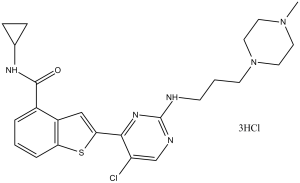LY2409881 trihydrochloride
This product is for research use only, not for human use. We do not sell to patients.

For small sizes, please check our retail website as below: www.invivochem.com
| Size | Price | Stock |
|---|---|---|
| 250mg | $1020 | Check With Us |
| 500mg | $1550 | Check With Us |
| 1g | $2325 | Check With Us |
Cat #: V0757 CAS #: 946518-60-1 Purity ≥ 98%
Description: LY2409881 trihydrochloride (LY-2409881; LY 2409881), the trihydrochloride salt of LY-2409881, is a novel, potent and selective IKK2 ( IκB kinase β) inhibitor with potential anticancer and anti-inflammatory activity.
Top Publications Citing Invivochem Products
Publications Citing InvivoChem Products
Product Promise

- Physicochemical and Storage Information
- Protocol
- Related Biological Data
- Stock Solution Preparation
- Quality Control Documentation
| Molecular Weight (MW) | 594.43 |
|---|---|
| Molecular Formula | C24H32Cl4N6OS |
| CAS No. | 946518-60-1 |
| Storage | -20℃ for 3 years in powder formr |
| -80℃ for 2 years in solvent | |
| Solubility In Vitro | DMSO: 20 mg/mL (33.6 mM)r |
| Water: <1 mg/mLr | |
| Ethanol: <1 mg/mL | |
| Solubility In Vivo | 2% DMSO+30% PEG 300+5% Tween 80+ddH2O: 5 mg/mL |
| SMILES Code | O=C(C1=C(C=C(C2=NC(NCCCN3CCN(C)CC3)=NC=C2Cl)S4)C4=CC=C1)NC5CC5.[H]Cl.[H]Cl.[H]Cl |
| Synonyms | LY2409881 tri-HCl; LY-2409881; LY 2409881; LY2409881 trihydrochloride |
| Protocol | In Vitro | LY2409881 is an IKK2 inhibitor that inhibits TNFα-induced activation of NF-κB. By in vitro kinase assay, LY2409881 potently inhibits IKK2, with an IC50 of 30 nM. In contrast, the IC50 for IKK1 and other common kinases is at least one log higher. The specificity of LY2409881 for NF-κB signaling is further studied in a cell-based assay, by examining the effect of LY2409881 in the TNFα-dependent antiapoptosis function. TNFα is a well-characterized upstream stimulus of NF-κB. In the ovarian cancer cell line SKOV3, LY2409881 demonstrates moderate cytotoxicity, whereas TNFα at 10 ng/mL does not cause any cytotoxicity. In contrast, coadministration of LY2409881 and TNFα results in markedly higher cell killing compared with LY2409881. This is because TNFα-dependent activation of antiapoptotic signals mediated by NF-κB is blocked by LY2409881, while the proapoptotic TNF receptor-associated death domain (TRADD) and FAS-associated death domain (FADD) cascade pathways activated by TNFα are not affected by LY2409881. |
|---|---|---|
| In Vivo | A well-established xenograft model of DLBCL is used to confirm the activity of LY2409881 in vivo. SCID-beige mice implanted with LY10 cell-derived tumors are given intraperitoneal injections of LY2409881 twice weekly at three different doses: 50, 100, and 200 mg/kg. The treatments are well tolerated, resulting in no death or severe morbidity of the mice. The average tumor volume is graphed as a function of time for each treatment group. The rates of tumor volume growth of the treatment groups are all significantly slower than the untreated control group (P≤0.01). |
These protocols are for reference only. InvivoChem does not
independently validate these methods.
| Solvent volume to be added | Mass (the weight of a compound) | |||
|---|---|---|---|---|
| Mother liquor concentration | 1mg | 5mg | 10mg | 20mg |
| 1mM | 1.6823 mL | 8.4114 mL | 16.8228 mL | 33.6457 mL |
| 5mM | 0.3365 mL | 1.6823 mL | 3.3646 mL | 6.7291 mL |
| 10mM | 0.1682 mL | 0.8411 mL | 1.6823 mL | 3.3646 mL |
| 20mM | 0.0841 mL | 0.4206 mL | 0.8411 mL | 1.6823 mL |
The molarity calculator equation
Mass(g) = Concentration(mol/L) × Volume(L) × Molecular Weight(g/mol)
Mass
=
Concentration
×
Volume
×
Molecular Weight*
The dilution calculator equation
Concentration(start)
×
Volume(start)
=
Concentration(final)
×
Volume(final)
This equation is commonly abbreviated as: C1 V1 = C2 V2
Concentration(start)
C1
×
Volume(start)
V1
=
Concentration(final)
C2
×
Volume(final)
V2
Step One: Enter information below
Dosage mg/kg
Average weight of animals g
Dosing volume per animal µL
Number of animals
Step Two: Enter the in vivo formulation
%DMSO
+
%
+
%Tween 80
+
%ddH2O
Calculation Results:
Working concentration:
mg/ml;
Method for preparing DMSO master liquid:
mg
drug pre-dissolved in
µL
DMSO(Master liquid concentration
mg/mL)
,Please contact us first if the concentration exceeds the DMSO solubility of the batch of drug.
Method for preparing in vivo formulation:
Take
µL
DMSO master liquid, next add
µL
PEG300, mix and clarify, next add
µL
Tween 80,mix and clarify, next add
µL
ddH2O,mix and clarify.
Note:
- (1) Please be sure that the solution is clear before the addition of next solvent. Dissolution methods like vortex, ultrasound or warming and heat may be used to aid dissolving.
- (2) Be sure to add the solvent(s) in order.




































